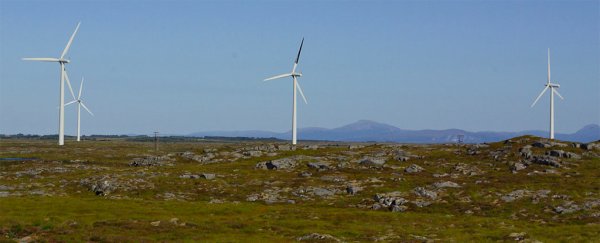As a source of clean energy, wind farms come with many benefits - but they can be a danger to local birds. A new study suggests a small tweak to the turbine design could make a big difference in terms of avian safety, and all it takes is a paint job.
In an experiment run on the Norwegian archipelago of Smøla, changing the colour of just one of the turbine blades to black led to an average of 70 percent annual reduction in bird fatalities, as measured over three and a half years. In a linked experiment, painting part of some of the turbine towers black also resulted in fewer bird deaths.
While the study only involved one wind farm and a small number of birds – six fatalities on the four painted turbines, 18 fatalities on the four non-painted control turbines – it points to a way of keeping birds from harm without major reengineering.
"In this case it was resource demanding to paint the rotor blades, since the wind turbines were already installed," says conservation biologist Roel May, from the Norwegian Institute for Nature Research (NINA).
"If the painting is done before construction, however, both the cost and the bird mortality will be reduced."
Very little data is available on just how many bird deaths are caused each year by wind turbines. Some estimates put it at the tens of thousands – that's not good news, though it's still a mere fraction of the avian fatalities caused by nuclear and fossil fuel power generation, and by birds hitting power lines (which runs into the tens of millions).
Painted blades could be one solution to the problem. The researchers think it makes the turbines more visible to birds, reducing what's known as motion smear – where moving objects are more difficult to get a visual lock on.
The study also looked at other possible ways of reducing bird deaths, such as covering blades with ultraviolet paint, and positioning turbines in such a way as to avoid areas of updraft that birds use to soar.
While the black blade-painting technique was the most conclusively effective in this case, other colours and techniques could be tried, the researchers say. It's a promising first step, but many more studies will be required across multiple sites to see what works best when it comes to keeping birds and turbine blades apart.
With more and more wind turbines coming online, the potential danger to birds and other animals will increase – though wind farm sites are already carefully chosen to keep the disruption levels to local ecosystems as low as possible.
According to Martin Harper, director for conservation at the Royal Society for the Protection of Birds (RSPB) in the UK, innovations like those outlined in this study can be combined to minimise the risk of harming wildlife.
Harper, who wasn't involved in the study, told the BBC: "Wind turbines are the right technology when we find the right places for them, so studies like this are valuable and build on our understanding of what additional mitigation could be used once we identify locations suitable for wind farms."
"As the report acknowledges, this studied a single site and more work needs to be done, so we would be interested in seeing more research in this area."
The research has been published in Ecology and Evolution.
